Paper Menu >>
Journal Menu >>
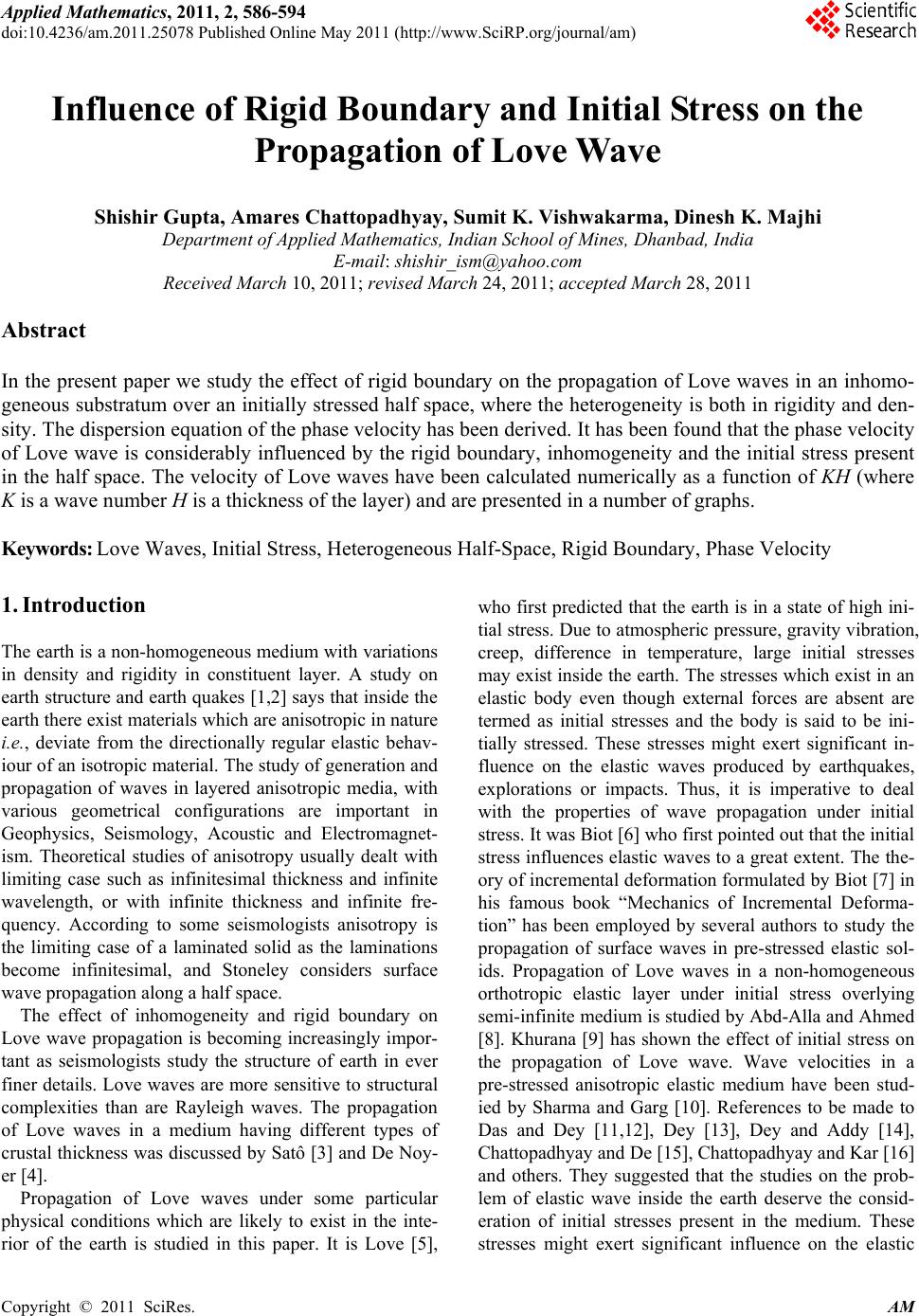 Applied Mathematics, 2011, 2, 586-594 doi:10.4236/am.2011.25078 Published Online May 2011 (http://www.SciRP.org/journal/am) Copyright © 2011 SciRes. AM Influence of Rigid Boundary and Initial Stress on the Propagation of Love Wave Shishir Gupta, Amares Chattopadhyay, Sumit K. Vishwakarma, Dinesh K. Majhi Department of Ap pl ie d M athematics, Indian School of Mines, Dhanbad, India E-mail: shishir_ism@yahoo.com Received March 10, 2011; revised March 24, 2011; accepted March 28, 2011 Abstract In the present paper we study the effect of rigid boundary on the propagation of Love waves in an inhomo- geneous substratum over an initially stressed half space, where the heterogeneity is both in rigidity and den- sity. The dispersion equation of the phase velocity has been derived. It has been found that the phase velocity of Love wave is considerably influenced by the rigid boundary, inhomogeneity and the initial stress present in the half space. The velocity of Love waves have been calculated numerically as a function of KH (where K is a wave number H is a thickness of the layer) and are presented in a number of graphs. Keywords: Love Waves, Initial Stress, Heterogeneous Half-Space, Rigid Boundary, Phase Velocity 1. Introduction The earth is a non-homogeneous medium with variations in density and rigidity in constituent layer. A study on earth structure and earth quakes [1,2] says that inside the earth there exist materials which are anisotropic in nature i.e., deviate from the directionally regular elastic behav- iour of an isotropic material. The study of generation and propagation of waves in layered anisotropic media, with various geometrical configurations are important in Geophysics, Seismology, Acoustic and Electromagnet- ism. Theoretical studies of anisotropy usually dealt with limiting case such as infinitesimal thickness and infinite wavelength, or with infinite thickness and infinite fre- quency. According to some seismologists anisotropy is the limiting case of a laminated solid as the laminations become infinitesimal, and Stoneley considers surface wave propagation along a half space. The effect of inhomogeneity and rigid boundary on Love wave propagation is becoming increasingly impor- tant as seismologists study the structure of earth in ever finer details. Love waves are more sensitive to structural complexities than are Rayleigh waves. The propagation of Love waves in a medium having different types of crustal thickness was discussed by Satô [3] and De Noy- er [4]. Propagation of Love waves under some particular physical conditions which are likely to exist in the inte- rior of the earth is studied in this paper. It is Love [5], who first predicted that the earth is in a state of high ini- tial stress. Due to atmospheric pressure, gravity vibration, creep, difference in temperature, large initial stresses may exist inside the earth. The stresses which exist in an elastic body even though external forces are absent are termed as initial stresses and the body is said to be ini- tially stressed. These stresses might exert significant in- fluence on the elastic waves produced by earthquakes, explorations or impacts. Thus, it is imperative to deal with the properties of wave propagation under initial stress. It was Biot [6] who first pointed out that the initial stress influences elastic waves to a great extent. The the- ory of incremental deformation formulated by Biot [7] in his famous book “Mechanics of Incremental Deforma- tion” has been employed by several authors to study the propagation of surface waves in pre-stressed elastic sol- ids. Propagation of Love waves in a non-homogeneous orthotropic elastic layer under initial stress overlying semi-infinite medium is studied by Abd-Alla and Ahmed [8]. Khurana [9] has shown the effect of initial stress on the propagation of Love wave. Wave velocities in a pre-stressed anisotropic elastic medium have been stud- ied by Sharma and Garg [10]. References to be made to Das and Dey [11,12], Dey [13], Dey and Addy [14], Chattopadhyay and De [15], Chattopadhyay and Kar [16] and others. They suggested that the studies on the prob- lem of elastic wave inside the earth deserve the consid- eration of initial stresses present in the medium. These stresses might exert significant influence on the elastic  S. GUPTA ET AL.587 waves produced by earthquakes, explorations or impacts. Thus, it is imperative to deal with the problems of wave propagation under initial stress. The near surface of the earth consists of layers of dif- ferent types of material properties overlying a half space of various types of rock, underground water, oil & gases. So, the studies of the propagation of seismic waves will be of great interest to seismologist. A detail study on elastic wave propagation and its generation in seismol- ogy had been made by Pujol [17] and Chapman [18]. In the present paper Love wave propagation in anisotropic layer of sandstone with rigid boundary over a pre- stressed orthotropic quartz medium has been studied. The inhomogeneity of the layer is taken into considera- tion by assuming 22 00 1, 1 N NmzLLmz 2 and , m is a constant and having dimen- 01mz sion that is inverse of length. Also the inhomogeneity of the half-space has been taken as 11az and 11bz where a, b are constants and having di- mensions that are inverse of length. The initial stresses P present in the inhomogeneous quartz half space also have effect in the velocity of propagation. The initial com- pressive stress is seen to reduce the velocity. The upper boundary plane of the layer is assumed to be rigid, and both the rigidity and the mass density of the underlying half space are assumed to increase linearly with depth. 2. Formulation and Solution of the Problem Consider an inhomogeneous anisotropic layer of finite thickness H over an initially stressed inhomogeneous quartz half-space. We assume that the upper surface of the crustal layer is rigid and horizontal. The -axis is taken vertically downwards in the lower medium. The z x -axis is chosen parallel to the layer in the direction of wave propagation, origin being taken at the depth H below the upper surface of the layer as shown in Fig- ure 1. and ,NL are the directional rigidities and density at any point in the layer which is assumed to be transversely isotropic with z-axis as the axis of sym- metry. The inhomogeneity of the layer has been taken as 22 00 1, 1NNmz LLmz and 2 01mz , mis a constant and having dimension that is inverse of length. In the half space rigidity and density vary linearly with depth i.e. 11az and where are constants and having dimensions that are inverses of length. 11bz ,ab 2.1. Solution for the Layer Let and be the displacement components in the x, y and z direction respectively. Starting from the general equation of motion and using the conventional Love waves conditions viz., and ,uv w 0, 0uw 1,,vvxzt, the only y component. Then the equation of motion in absence of body force can be written as [7] 22 11 22 vv NL zz 1 v x t (1) For a wave propagating along x -direction, we may assume 1eiK xct vVz (2) Using Equation (2), Equation (1) takes the form 22 2 2 d1dd 0 dd d VLVK cNV Lz zL z (3) After putting 1 V VL in Equation (3), we get Figure 1. Geometry of the problem. P 1 1 1 1 az bz 2 0 2 0 2 0 1 1 1 N Nmz LL mz mz H Inhomogeneous Anisotropic Layer Inhomogeneous Quartz Half-Space Z = 0 Z = –H Rigid boundary x P z Copyright © 2011 SciRes. AM  S. GUPTA ET AL. 588 2 222 2 1 11 222 d1d1 d0 2d dd4 VLLK VVcN LzL zzL 1 V (4) The variations in rigidities and density are taken as 22 00 1, 1NNmzLLmz and 2 01mz (5) wheremis a constant having dimension inverse of leng- th. Using Equation (5), Equation (4) changes to 2 2 1 11 2 d0 d VmV z (6) where 2 22 10 0 K mcN L 0 (7) The solution of Equation (6) may be assumed as 11 1ee im zim z VA B Thus the solution for the non-homogeneous, anisot- ropic layer may be taken as 11 1 0 e ee 1 im zim ziK xct AB vLmz (8) 2.2. Solution for the Half-Space The lower medium is considered as inhomogeneous quartz half-space under initial horizontal compressive stress along x-axis. The eqn. of motion correspond- ing to the displacement due to Love waves can be written as [7] P 22 23 21 2 22 2 s sPv v xz xt (9) whereij s are the incremental stress components in the half-space, is the initial compressive stress along the x-direction, and P is the density of the material of the half space. In the present problem we have 11az and 1 1bz (10) Using the stress-strain relations 21 23 2, 2 x yyz s es e (11) And the relation (10), the equation of motion (9) can be written as 22 2 1 22 2 22 11 1 1211 1 bz vv vv Pa azaz zaz 2 2 x zt (12) Let 2e x ctiK vVz (13) be the solution of Equation (12). Using Equation (13), Equation (12) takes the form 2 12 2 11 1 dd 1 1d 121 d bz VaV P c az zazaz z 2 0K V (14) Putting 1/2 () 1 z Vaz in Equation (14) to eliminate the term dV dz , we get 22 // 2 22 1 1 () 10 21 1 41 os bz aPc zK az az c az z (15) where 1 0 os c and is phase velocity. Substituting c 1/ 2 2 1 12 1 21 1, , 21 os Kaz Pcb K c az aa c in Equation (15) we get 2 22 d11 0 24 d4 R (16) where 2 22 1os ab RcaK Equation (16) is a Whittaker’s equation, solution of which may be written as Copyright © 2011 SciRes. AM  S. GUPTA ET AL.589 12,02 2,0RR DW DW where 1 and 2 are arbitrary constants and /2,0R D D W is the Whittaker’s function. The solution of Equation (16) satisfying the condition when i.e. lim z Vz0lim when may be ta- ken as 0 1/2,0R DW (17) Hence, the displacement component in the heteroge- neous half-space is given by 12,0 2ee 112 R iKxctikx ct DW vVz az (18) Expanding Whittaker’s function up to linear terms Equation (18) reduces to 1 21 2 /2 (1 ) 1 1/ 23/ 2 1 1 21 2 1 ee 121 KR az iK xct a K Ra az vD aaz az (19) Boundary Conditions and Dispersion equation 12 1 At the interface, 0 the continuity of the stress requires that At rigid boundary , the displacement is vanishing so that =0, at and the continuity of the displacement requires yz y zf zHv zH 12 that at 0 vv z (20) where y f is the incremental boundary force per unit initial area in the pre-stressed half-space at deformed stage, the physical explanations of which may be ob- tained from Figure 2. In the boundary conditions the quantities (i.e. y f and for the stratum (inhomoge- neous and anisotropic) and lower half-space are denoted by the subscripts 1 and 2 respectively. )v The magnitude of y f as derived by [7] is iij ij kjikik jk j f sSwSeSen where are the initial stress components, ij Sij s are the incremental stress components, are the strain com- ponents, are the rotational components, is the dilatation and ij e ij we j nis the cosine of angle between the th j direction and normal to the surface. It is obvious that z f is the incremental normal force per unit area to the boundary whereas, x f and y f are shear forces. In the present problem, since is the only initial stress com- 11 S ponent, ,,xzt 222 2 0vv w,u0, and also z- axis is normal to the boundary. 2 23yv fs z Using boundary conditions (20) in Equation (8) and Equation (19), we get 01001011 0AL immLBL immLDK 0 (21) 11 ee im HimH AB (22) 102 0AB DLK (23) where 1 1 22 /2 1 10 1 11 2 /2 1 2 1 11 2322 e1 2222 2 1 22 e1 2 R K a R K a RR aa aa aR KK aKK Ra KaK ., Eliminating , A Band from Equations (21)-(23), we get 1 D 01 001 01 11 e e 0 1 im Him H LimmLLimmLK 02 0 1 LK Copyright © 2011 SciRes. AM 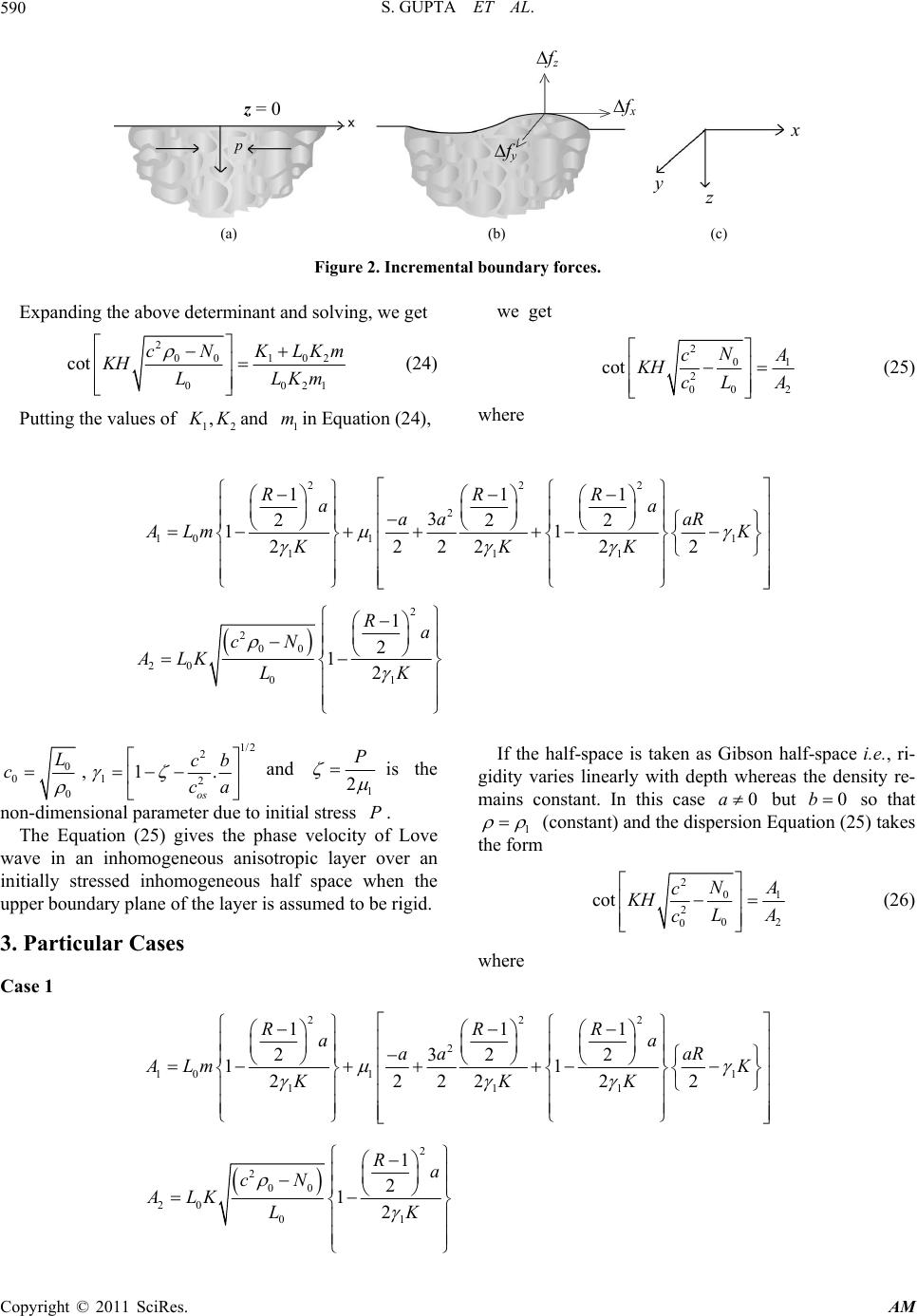 S. GUPTA ET AL. 590 (a) (b) (c) Figure 2. Incremental bounda r y forc es. Expanding the above determinant and solving, we get z ∆fz ∆fx ∆fy x y z = 0 p 2 00 102 0021 m (24) cot cN KH LLK KLKm Putting the values of 12 , K Kand 1 min Equation (24), we get 2N01 2 02 0 otcc A KH LA c (25) where 222 2 1 1 3 22 aa 01 111 111 2 11 222222 RRR aa aR A Lm K KKK 2 2 00 20 01 1 2 12 Ra cN ALK LK 1/2 2 0 01 2 0 , 1. os Lcb ca c and 1 2 P itial stress P is the non-dimensional parameter due to in The Equation (25) gives the phase velocity of Love in an inhomogeneous anisotropic layer over an initially stressed inhomogeneousspace wh upper boundary plane of the layer is assumed to be rigid. 3. If the half-space is taken as Gibson half-space i.e., ri- gidity varies linearly with depth whereas the density re- mains constant. In this case but so that . wave half en the Particular Cases Case 1 0a0b 1 the form (constant) and the disp Equ25) takes ersionation ( 2 01 2 02 0 cot N A c KH LA c (26) where 2 11RR 22 2 1 1 111 1 3 222 11 222 22 R aa aa aR 10 2 A L m K KKK 2 2 00 20 01 1 2 12 Ra cN ALK LK Copyright © 2011 SciRes. AM 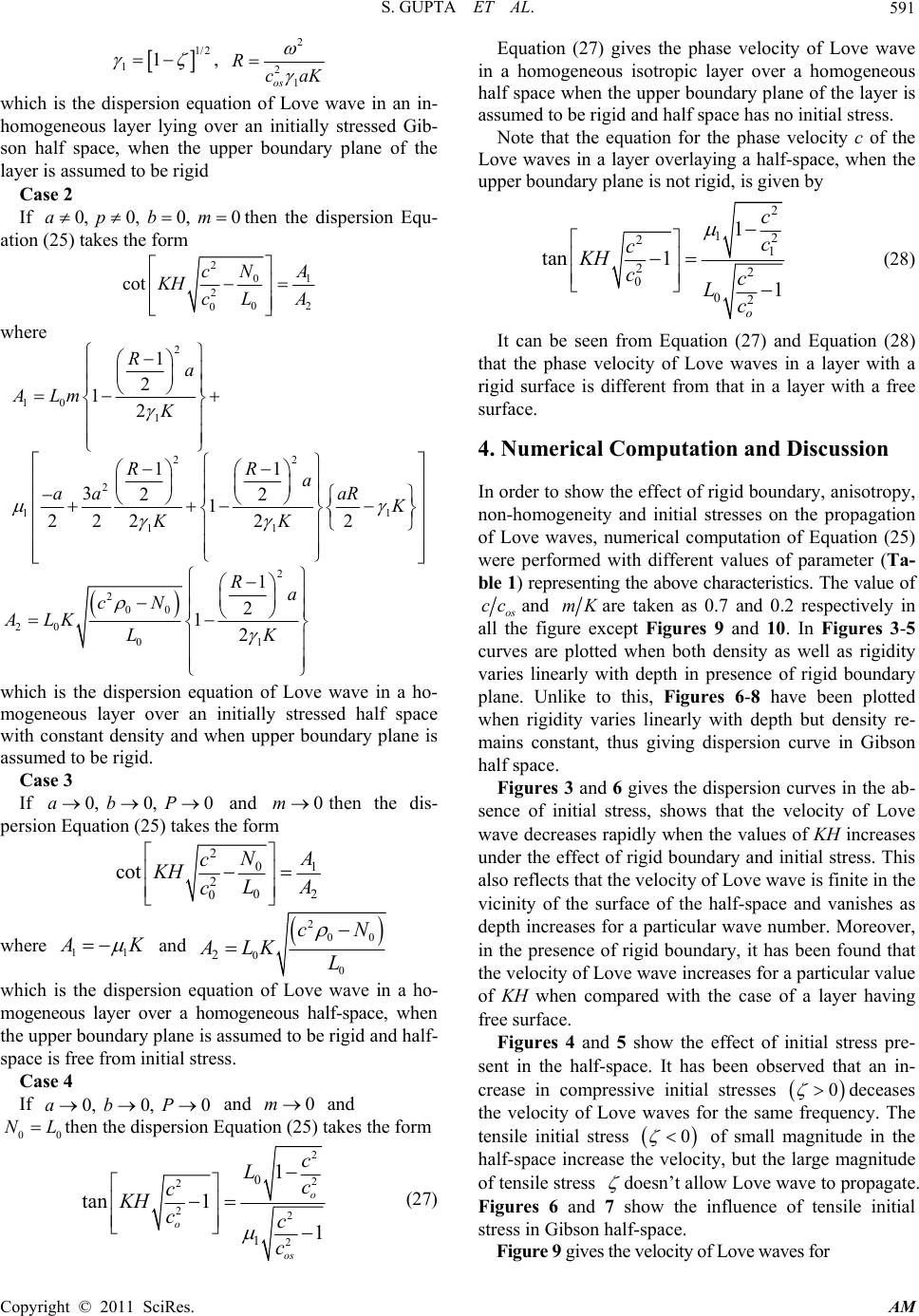 S. GUPTA ET AL.591 1/2 11 , 2 2 1os RcaK which is the dispersion equation of Love wave in an in- homogeneous layer lying over an initially stressed Gib- son half space, when the upper boundary plane of the layer is assumed to be rigid Case 2 If 0, 0, 0, 0apbmthen the dispersion Equ- ation (25) takes the form 2 01 2 0 cot N 02 A c KH c LA where 2 10 1 22 2 11 11 1Ra 2 12 11 322 1 22 22 2 AL mK RR a aa aR K KK 2 2 00 20 01 1 2 12 Ra cN ALK LK which is the dispersion equation of Love wave in a ho- mogeneous layer over an initially stressed half space with constant density and when upper boundary plane is assumed to be rigid. Case 3 If 0, 0, 0abP and 0mthen the dis- persion Equation (25) takes the form 2 01 cot NA c KH 2 02 0LA c where 11 AK and 2 00 0 2 N ALK 0 c L which is the dispersion equation of Loveave in a ho- mogeneous layer over a homogeneous half-space, when the upper boundary plane is assumed to be rigid and half- free from initial stress. 4 w space is Case If 0, 0, 0abP and 0m and 00 NLthen the dispersion Equation (25) takes the form 2 21c L c 2 22 0 tan 1o o c KH cc 2 11 os c (27) Equation (27) gives the phase velocity of Love wave in a homogeneous isotropic layer over a homogeneous half space when the upper boundary plane of the layer is assumed to be rigid and half space has no initial stress. Note that the equation for the phase velocity c of the Love waves in a layer overlaying a half-space, when the upper boundary plane is not rigid, is given by 2 12 21 22 0 021 o c Lc It can be seen from Equation (27) and Equation (28) that the phase velocity of Love waves in a layer with 1 tan 1 c c c KH c (28) a rig 4. Numerical Computation and Discussion In order to show the effect of rigid boun non-homogeneity and initial stresses on of Love waves, numerical computation of Equation (25) were performed with different values of parameter (Ta- bl id surface is different from that in a layer with a free surface. dary, anisotropy, the propagation e 1) representing the above characteristics. The value of os cc and mKare taken as 0.7 and 0.2 respectively in all the figure except Figures 9 and 10. In Figures 3-5 curves are plotted when both density as well as rigidity varies linearly with depth in presence of rigid boundary ted when rigidity varies linearly with depth but density under ffect plane. Unlike to this, Figures 6-8 have been plot re- mains constant, thus giving dispersion curve in Gibson half space. Figures 3 and 6 gives the dispersion curves in the ab- sence of initial stress, shows that the velocity of Love wave decreases rapidly when the values of KH increases the e of rigid boundary and initial stress. This also reflects that the velocity of Love wave is finite in the vicinity of the surface of the half-space and vanishes as depth increases for a particular wave number. Moreover, in the presence of rigid boundary, it has been found that the velocity of Love wave increases for a particular value of KH when compared with the case of a layer having free surface. Figures 4 and 5 show the effect of initial stress pre- sent in the half-space. It has been observed that an in- crease in compressive initial stresses 0 deceases the velocity of Love waves for the same frequency. The tensile initial stress 0 of small magnitude in the half-space increase the velocity, but the large magnitude of tensile stress doesn’t allow Love wave to propagate. Figures 6 and 7 show the influence of tensile initial stress in Gibson half-space. Figure 9 gives the velocity of Love waves for Copyright © 2011 SciRes. AM 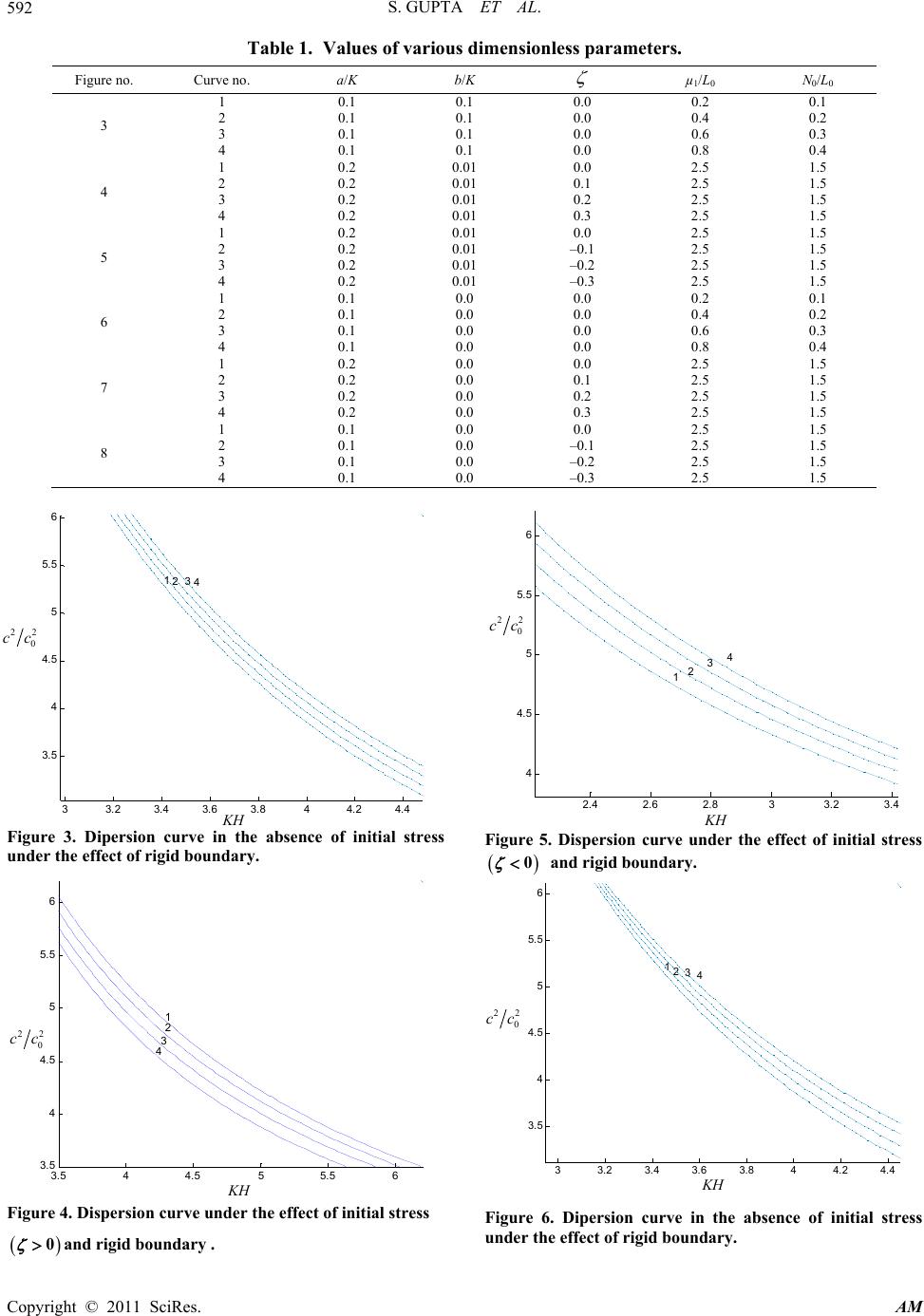 S. GUPTA ET AL. 592 3.5 44.5 55.5 6 3.5 4 4.5 5 5.5 6 KH 0 2 1 c 2 /c 2 3 4 diters. no. Curve no. a/K b/K Table 1. Values of various Figure mensionless parame µ1/L0 N0/L0 3 1 2 3 4 0.1 0.1 0.1 0.1 0.0 0.0 0.0 0.0 0.2 0.4 0.6 0. 0.1 0.2 0.3 0.1 0.1 0.1 0.1 8 0.4 4 3 01 0.3 2.5 1.5 1 2 0.2 0. 4 0.2 0.2 0.01 0.01 0.1 0.2 0.2 0.01 0.0 2.5 2.5 1.5 1.5 2.5 1.5 5 1 2 3 4 1 0.2 0.2 0.2 0.2 0.1 0.01 0.01 0.01 0.01 0.0 0.0 –0.1 –0.2 –0.3 0.0 2.5 2.5 2.5 2.5 0.2 1.5 1.5 1.5 1.5 0.1 6 2 3 4 0.1 0.1 0.1 0.0 0.0 0.0 0.0 0.0 0.0 0.4 0.6 0.8 0.2 0.3 0.4 7 1 2 3 4 1 0.2 0.2 0.2 0.2 0.1 0.0 0.0 0.0 0.0 0.0 0.0 0.1 0.2 0.3 0.0 2.5 2.5 2.5 2.5 2.5 1.5 1.5 1.5 1.5 1.5 8 2 3 4 0.1 0.1 0.1 0.0 0.0 0.0 –0.1 –0.2 –0.3 2.5 2.5 2.5 1.5 1.5 1.5 igure 3. Dipersion curve in the absence of initial stress nder the effect of rigid boundary. Figure 4. Dispersion curve under the effect of initial stress and rigid boundary . F u 0 Figure 5. Dispersion curve under the effect of initial stress 0 and rigid boundary. igure 6. Dipersion curve in the absence of initial F stress nder the effe ct of rigid boundary. u 33.2 3.4 3.6 3.8 44.2 4. 4 3. 5 4 4. 5 5 5. 5 6 KH c 1 2 2 /c 0 23 4 2.4 2.6 2.8 33.2 3.4 4 4. 5 5 5. 5 6 KH c 2 /c 0 2 1234 33.2 3.4 3.6 3.844.2 4.4 3.5 4 4.5 5 5.5 6 KH 1 c 2 /c 0 2 234 KH KH KH KH 22 c0 c 22 0 cc 22 0 cc 22 0 cc Copyright © 2011 SciRes. AM  S. GUPTA ET AL.593 igure 7. Dispersion curve under the effect of initial stress F 0 and rigid boundary . ress Figure 8. Dispersion curve under the effect of initial st 0 and rigid boundary. Figure 9. Dimensionless phase speed 22 0 cc as function of imensionless KH evaluated from Equation (27) for d .,.,. 0110 1520 Land 2. 0os02cc . 5 Figure 10. Dimensi onless phas e spee d 22 0 cc as function of dimensionless KH evaluated from Equation (28) for .,.,. 0110 1520 L and 2. 0os02cc . 2 01 0.2cc in a layer overmogeneous half-space e la a ho when the upper boundary plane of thyer is assumed to be rigid. While Figure 10 gives the speed of Love waves for 2 cc ous layer over a 01 .2in a homog r r ckwell Publishing, Ox003. ] P. M. Shearer, “Introduction to Seismology,” 2nd Edition, Cambridge yo, Tokyo, 1952 Publication, New York, 0ene homogeneous half-space in the absence of rigid bound- y plane. It is observed that overburden layer has a rominent effect. It is also observed that magnitudes of peed are changed in entire range of KH along with re- ersing the positions of the curve. ledgements he author conveys their sincere thanks to Indian School f Mines, Dhanbad, for providing JRF, Mr. Sumit Kuma ishwakarma and also facilitating us with best facility. e are also grateful to the honourable referees for their valuable suggestions for improving the manuscript. . References a p s v 5. Acknow T o V W in 6 [1] S. Stein and M. Wysession, “An Introduction to Seis- mology, Earthquakes and Earth Structure,” Bla ford, 2 [2 University Press, Cambridge, 2009. [3] Y. Satô, “Study on Surface Waves VI: Generation of Love and Other Type of SH-Waves,” Departmental Bul- letin Paper, Bulletin Earthquake Research Institute, Uni- versity of Tok, pp.101-120. [4] J. D. Noyer, “The Effect of Variations in Layer Thickness on Love Waves,” Bulletin of Seismology Society of Ame- rica, Vol. 51, No. 2, 1961, pp. 227-235. [5] A. E. H. Love, “A Treatise on Mathematical Theory of Elasticity,” 4th Edition, Dover 22.2 2.4 2.62.833.2 4 4.5 5 5.5 6 KH 1 c 2 /c 0 2 2 3 4 22.22.42.62.833.2 3.5 4 4.5 5 5.5 6 KH c 1 2 /c 0 2 234 0.8 11.2 1.4 1.6 1.822.2 1. 2 1. 3 1. 4 1. 5 1. 6 1. 7 1. 8 1. 9 KH c 2 /c 0 2 123 1.2 1.3 1.41.5 1.6 1.7 1.8 1.9 22.1 2.2 4 4.1 4.2 4.3 4.4 4.5 4.6 4. 7 4.8 4.9 KH c 1 2 /c 0 2 2 3 KH KH KH KH 22 0 22 0 cc 22 0 cc cc 22 0 cc Copyright © 2011 SciRes. AM 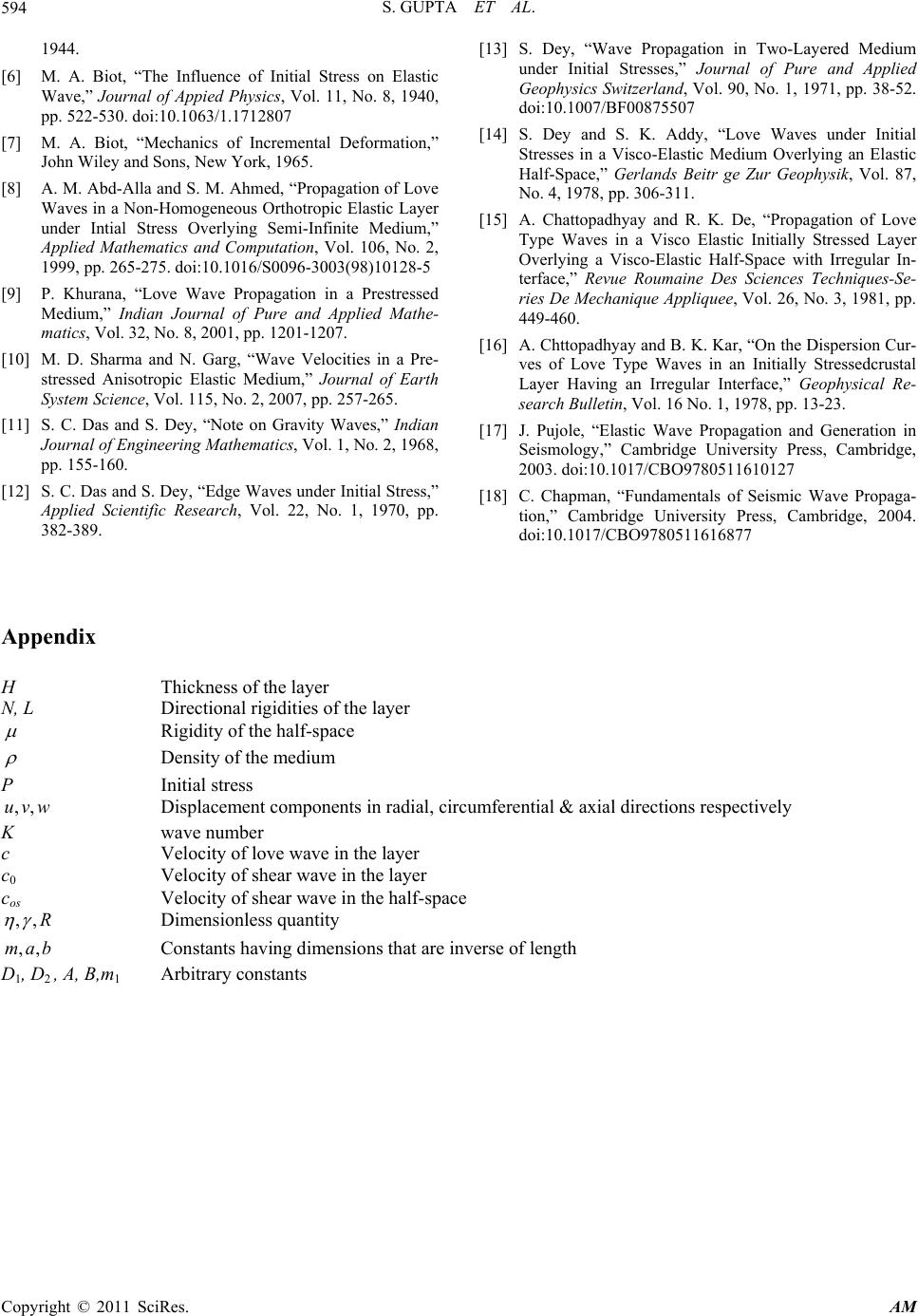 S. GUPTA ET AL. Copyright © 2011 SciRes. AM 594 1944. ce of Initial Stress on Elastic Wave,” Journal of Appied Physics, Vol. 11, No. 8, 1940, yer under Intial Stress Overlying Semi-Infinite Medium,” matics and Computation, Vol. 106, No 75. doi:10.1016/S0096-3003(98)10128-5 1, pp. 1201-1207. , pp. 38-52. astic yay and R. K. De, “Propagation of Love [13] S. Dey, “Wave Propagation in Two-Layered Medium under Initial Stresses,” Journal of Pure and Applied Geophysics Switzerland, Vol. 90, No. 1, 1971 [6] M. A. Biot, “The Influen pp. 522-530. doi:10.1063/1.1712807 [7] M. A. Biot, “Mechanics of Incremental Deformation,” John Wiley and Sons, New York, 1965. [8] A. M. Abd-Alla and S. M. Ahmed, “Propagation of Love Waves in a Non-Homogeneous Orthotropic Elastic La Half doi:10.1007/BF00875507 [14] S. Dey and S. K. Addy, “Love Waves under Initial Stresses in a Visco-Elastic Medium Overlying an El . 2, T -Space,” Gerlands Beitr ge Zur Geophysik, Vol. 87, No. 4, 1978, pp. 306-311. [15] A. Chattopadh ype Waves in a Visco Elastic Initially Stressed Layer Overlying a Visco-Elastic Half-Space with Irregular In- terface,” Revue Roumaine Des Sciences Techniques-Se- Applied Mathe 1999, pp. 265-2 [9] P. Khurana, “Love Wave Propagation in a Prestressed Medium,” Indian Journal of Pure and Applied Mathe- matics, Vol. 32, No. 8, 200 ries De Mechanique Appliquee, Vol. 26, No. 3, 1981, pp. 449-460. [16] A. Chttopadhyay and B. K. Kar, “On the Dispersion Cur- ves of Love Type Waves in an Initially Stressedcrustal [10] M. D. Sharma and N. Garg, “Wave Velocities in a Pre- stressed Anisotropic Elastic Medium,” Journal of Earth Layer Having an Irregular Interface,” Geophysical Re- search Bulletin, Vol. 16 No. 1, 1978, pp. 13-23. [17] J. Pujole, “Elastic Wave Propagation and Generation in Seismology,” Cambridge University Press, Cambridge, System Science, Vol. 115, No. 2, 2007, pp. 257-265. [11] S. C. Das and S. Dey, “Note on Gravity Waves,” Indian Journal of Engineering Mathematics, Vol. 1, No. 2, 1968, pp. 155-160. 2003. doi:10.1017/CBO9780511610127 [18] C. Chapman, “Fundamentals of Seismic Wave Propaga- tion,” Cambridge University Press, Cambridge, 2004. doi:10.1017/CBO9780511616877 [12] S. C. Das and S. Dey, “Edge Waves under Initial Stress,” Applied Scientific Research, Vol. 22, No. 1, 1970, pp. 382-389. Appendix H Thickness of the layer N, L Directional rigidities of the layer Rigidity of the half-space Density of the medium P Initial stress ,,uvw Displacement components in radial, ci K wave number rcumferential & axial directions respectively Velocity of love wave in the layer Velocity of shear wave in the layer Velocity of shear wave in the half-space c c0 cos ,,R Dimensionless quantity s that are inverse of length ,,mab Constants having dimension D1, D2 , A, B,m1 Arbitrary constants |

